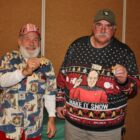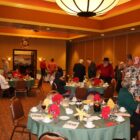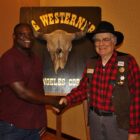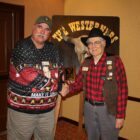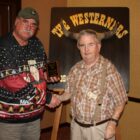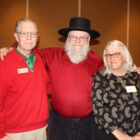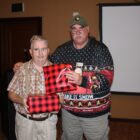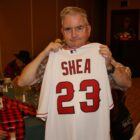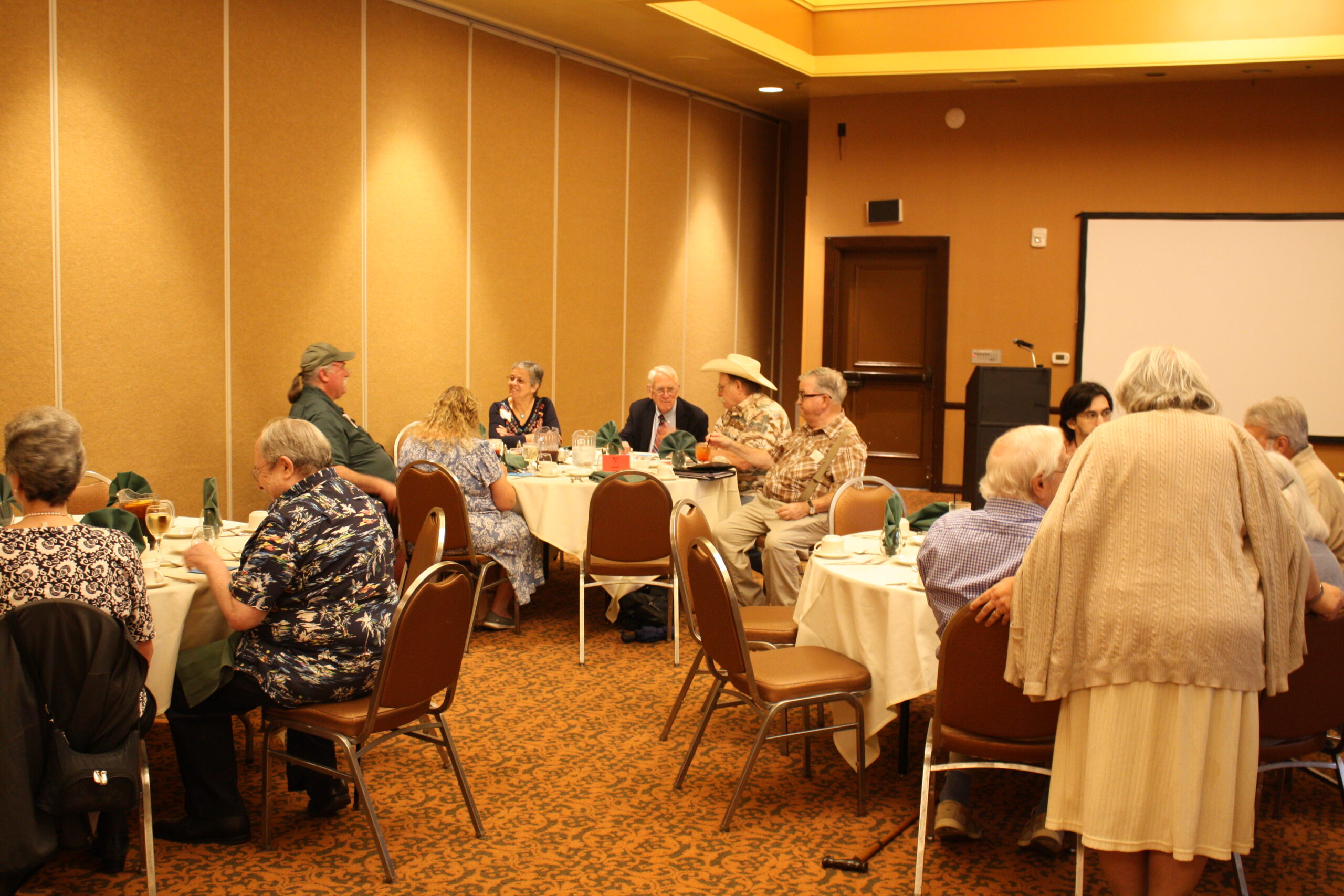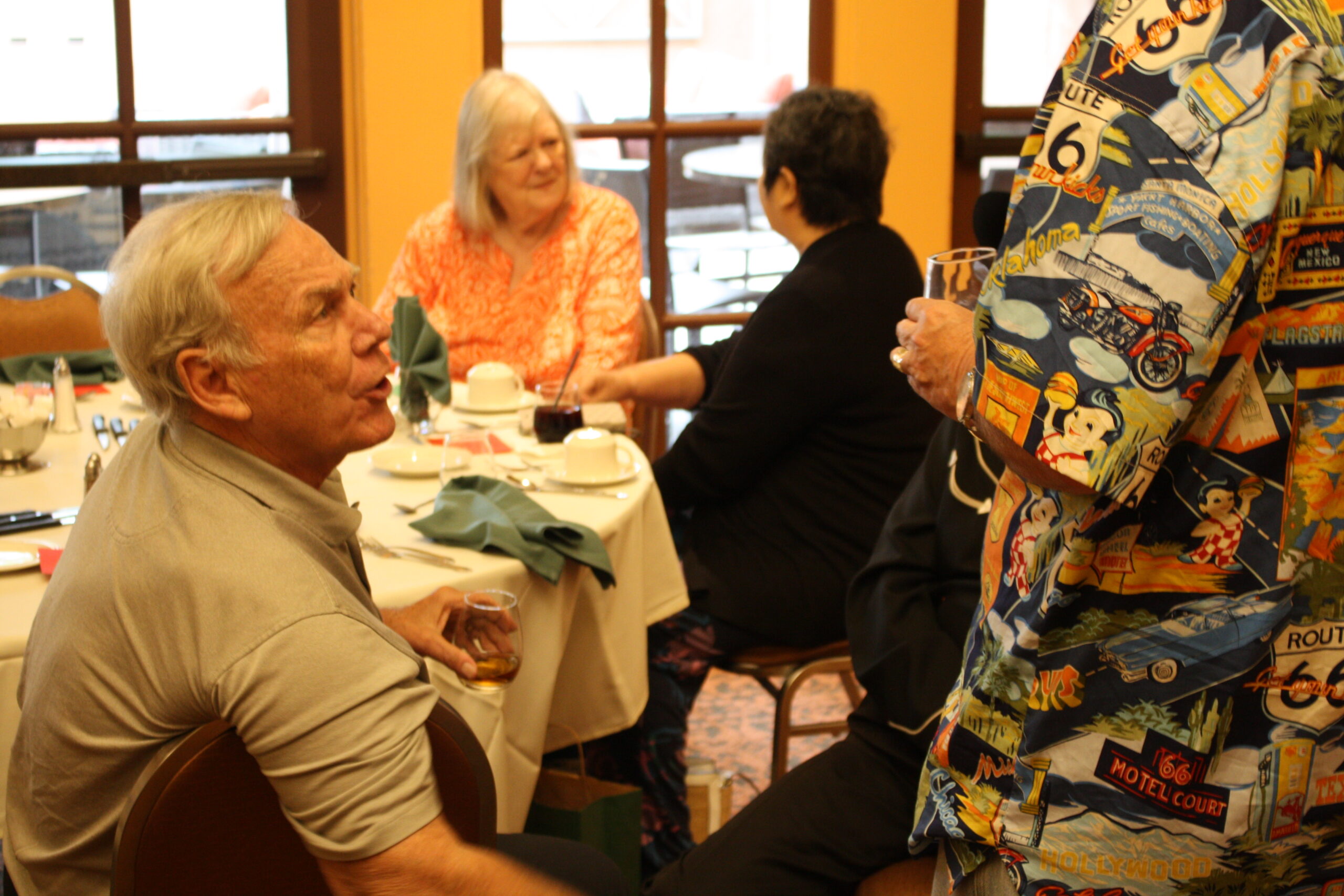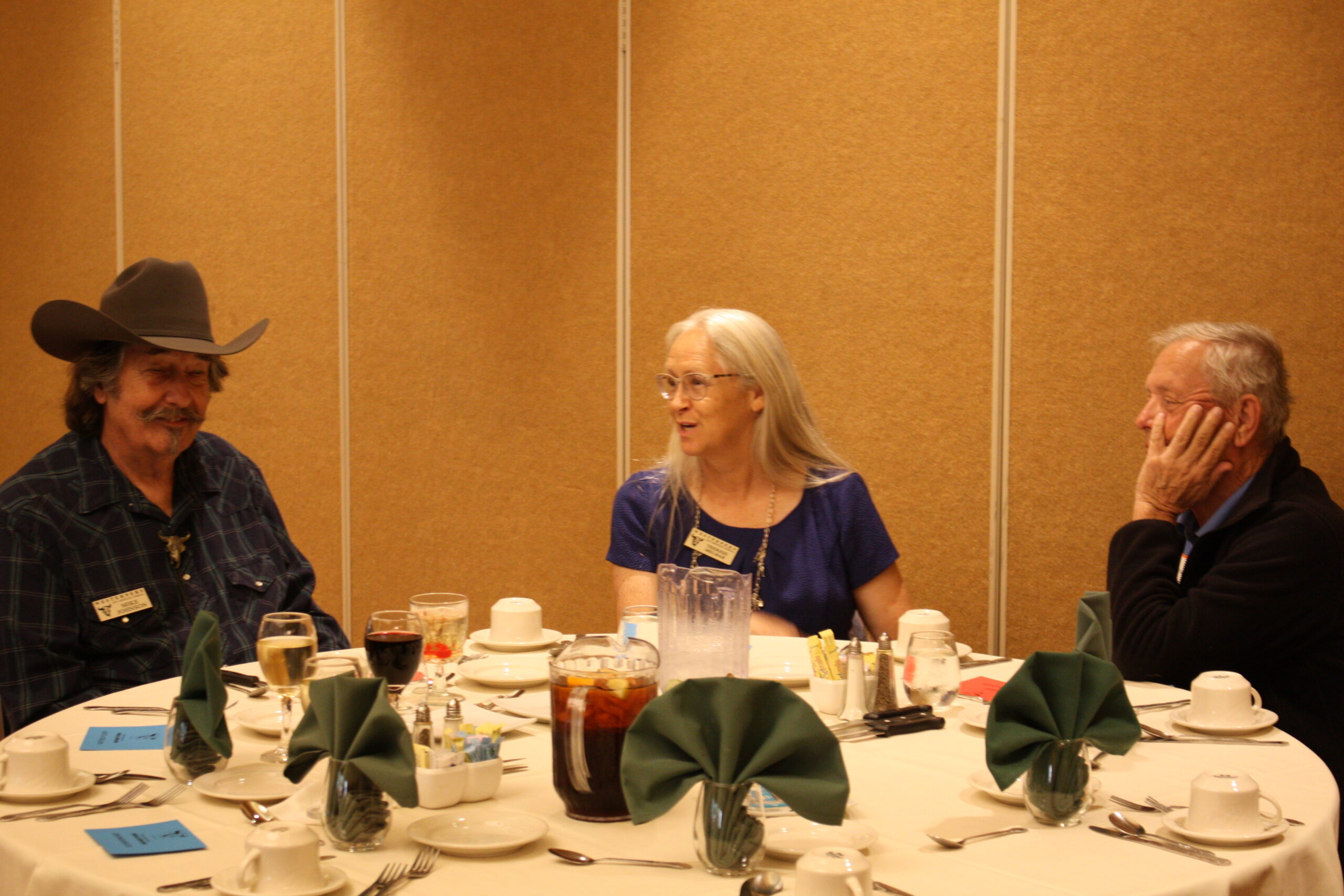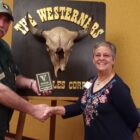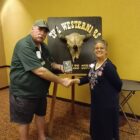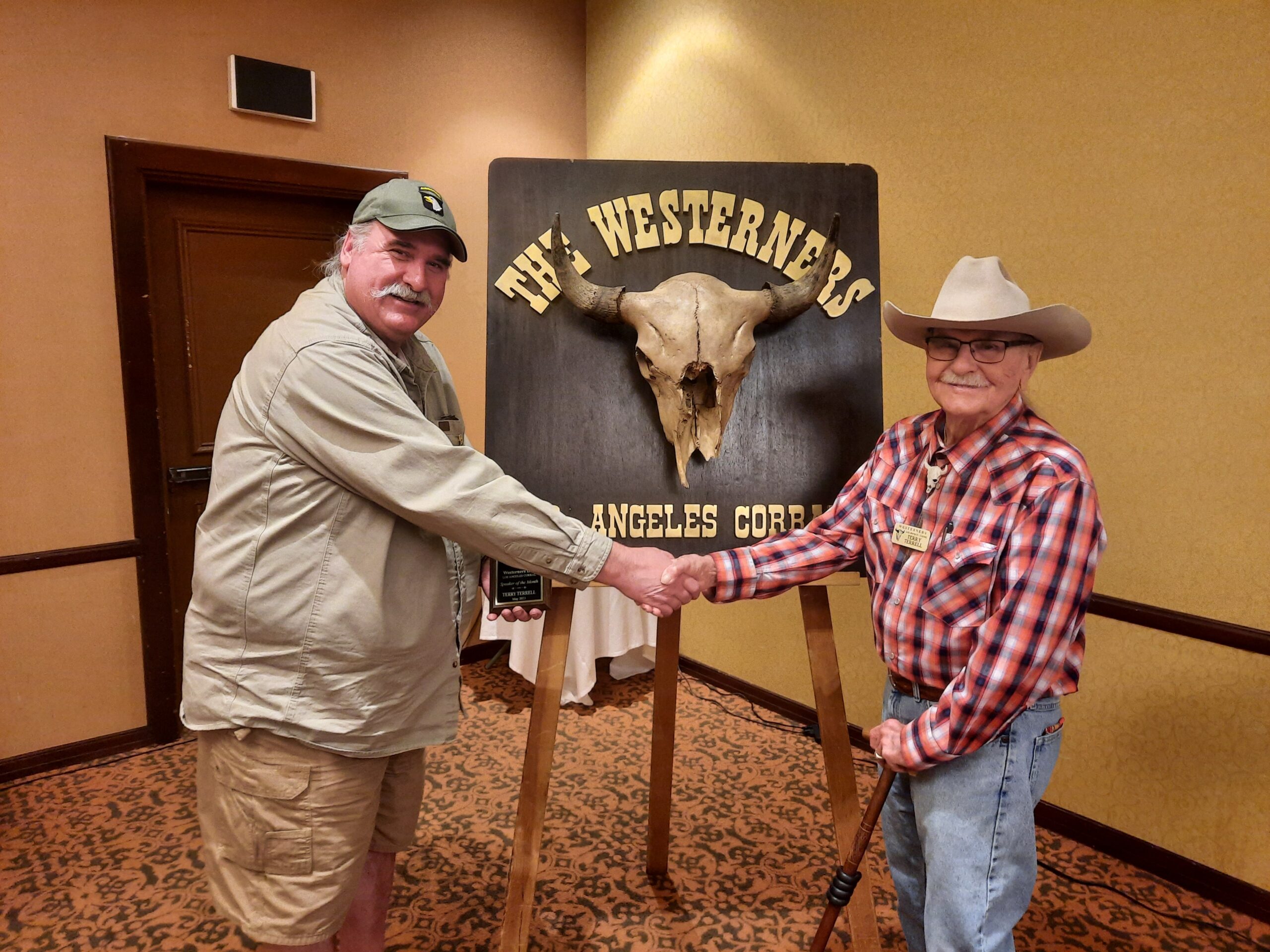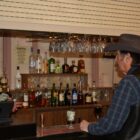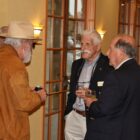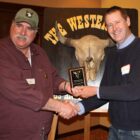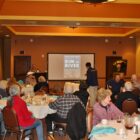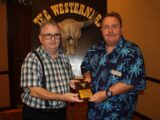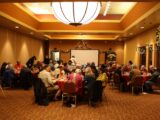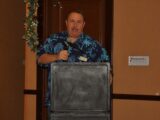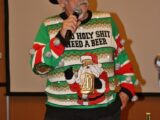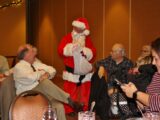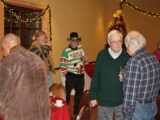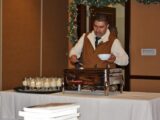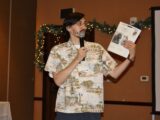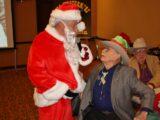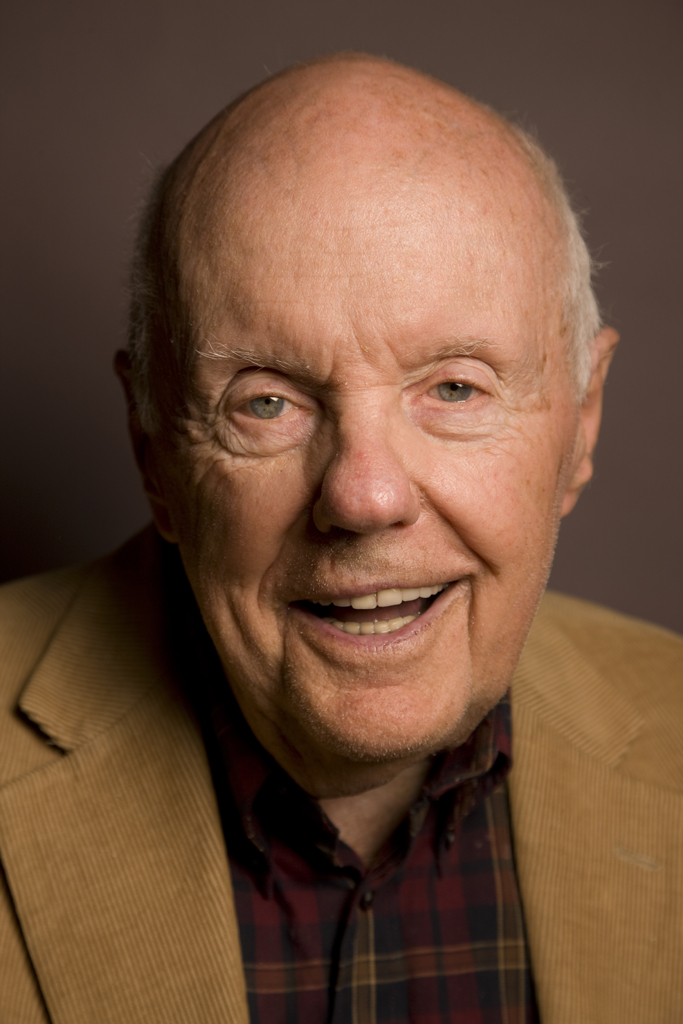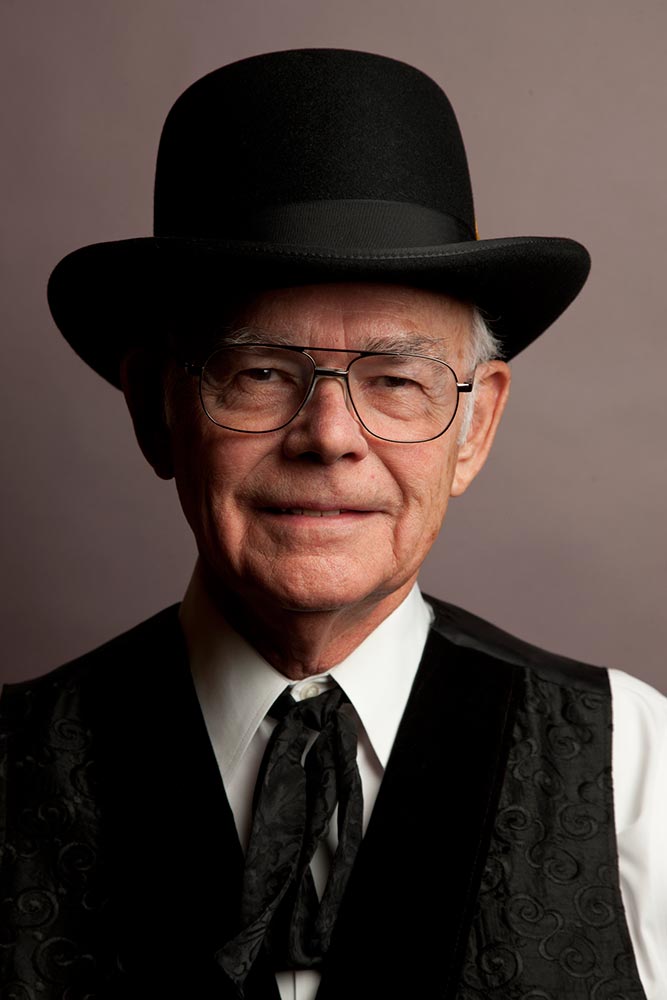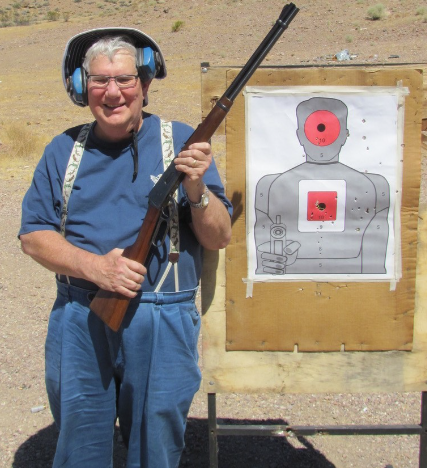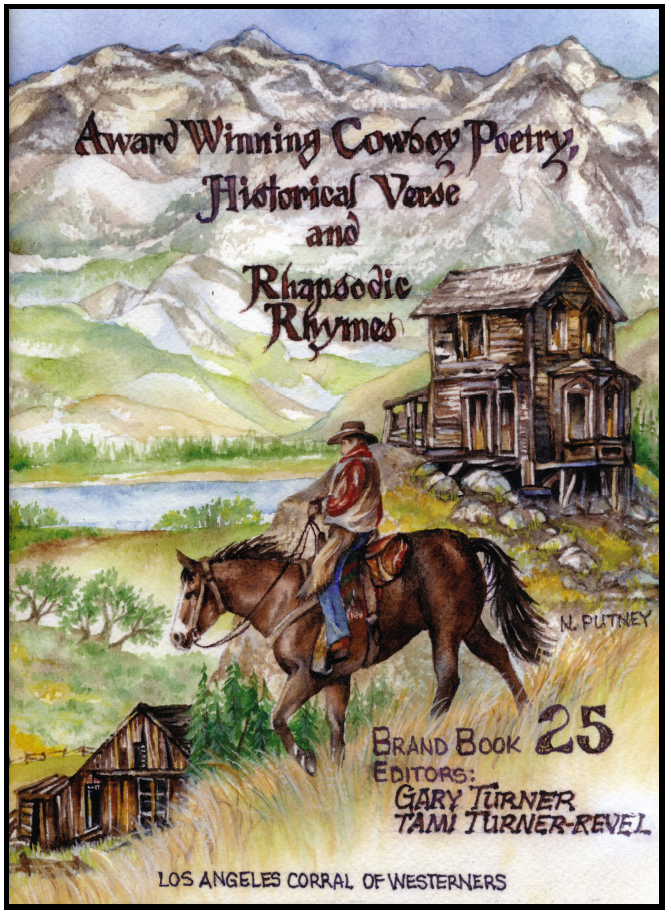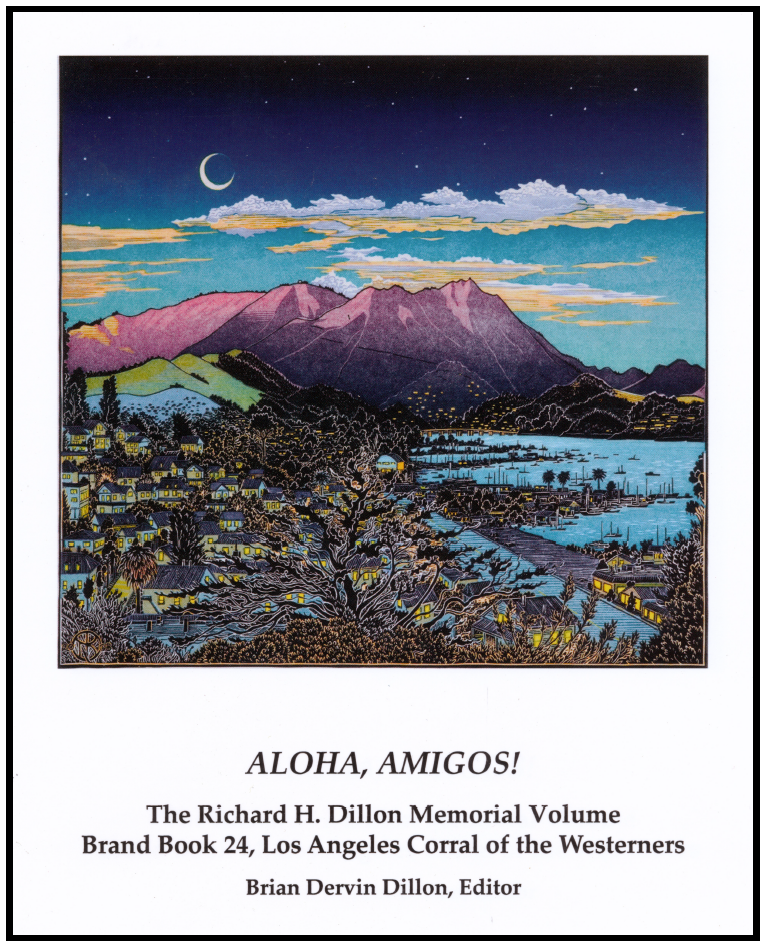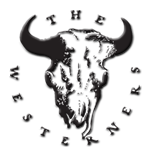Roundup: December 13th 2023
Westerners December 2023 Flyer
Roundup Synopsis
TBD
Photos from the Roundup
Roundup: July 12 2023
Westerners-July-2023-Draft-I-Roundup-Flyer-CORRECTED-6.18.23
Roundup Synopsis
TBD
Photos from the Roundup
Roundup: May 10 2023
Westerners-May-2023-IT-IS-A-GO-2
Roundup Synopsis
The Los Angeles Corral’s own Terry Terrell spoke at the May Roundup about the colorful, high-flying life of Florence Leontine Lowe, better known as Pancho Barnes. In another installment of what could come to be known as our Women of the West series—following Ed Anderson’s March talk, Pioneers in Petticoats—Terry directed our attention to the rich world of aviation and dude-ranching in the first half of the 20th century, that has become so emblematic of our own city’s historical character. Part rancher and restaurateur, part pioneering aviatrix and arial bootlegger, part hostess and perhaps even part madam, Pancho Barnes’ eccentric life added more than a few dabs of color to the mural of her unique character.
Though she was born Florence Leontine Lowe, granddaughter to Thaddeus Lowe, it was under her moniker “Pancho” and married name Barnes that she would gain fame. Pancho opened a ranch near Muroc Field (the future Edwards Air Force Base) in the mid-1930s which became home to the “Happy Bottom Riding Club.” Its name came from a remark by a guest after a ride on Pancho’s horse. The restaurant and inn, along with its own private airstrip, drew the rich and famous (and rugged) to the ranch in droves. In my favorite anecdote of the evening, Terry described the circumstances around legendary test pilot Chuck Yeager being “sundowned” at the ranch.
Out riding late one day in 1947, Chuck Yeager returned to the ranch after sundown. Thanks to the low light, Yeager didn’t notice that the corral gate, open when he began his ride, had been shut some time earlier. The horse he was riding sure noticed, though. When it stopped abruptly at the gate, Chuck was sent base over apex, breaking a few ribs on touchdown. One wonders if the libations proffered by Pancho at the ranch played a role in this misfortune. Regardless, Chuck had a job to do, broken ribs or no. The next day he closed the cockpit on Glamorous Glennis—the X-1 rocket plane named after his wife—with the aid of a broomhandle, and flew into the history books faster than the speed of sound.
Pancho never flew quite so fast, though she did best Emilia Earhart’s women’s speed record in the ‘30s. Barnes also formed a Hollywood union of pilots, and provided the dogfight sounds for Howard Hughes’ epic Hell’s Angels movie in 1930. A crack-pilot, ready hostess, and peer to some of the biggest names of her time, Pancho Barnes was a fixture for decades in the gritty and glitzy world of Hollywood’s Golden Age. It’s tough to think of a more fitting embodiment of the spirit of Southern California in that era.
Pancho was a one-of-a-kind lady, and an inspiration for all the adventurous types to follow. Let’s find more Pancho Barneses to celebrate. Let’s make this Women of the West series a reality. Who’s next?
— Alan Griffin
Photos from the Roundup
Roundup: April 12 2023
WLAC-Los-Angeles-Corral-4.12.23-RoundUp-Flyer
Roundup Synopsis
The Los Angeles Westerners gave a warm Southern California welcome to author and 4th-generation Arizonian Tom Zoellner during our April Roundup. Zoellner discussed the history of Arizona and his travels within it, which is the topic of his recently-published memoir, From Rim to River.
This book is Zoellner’s personal love letter to his home state of Arizona, with which he has a complicated relationship. The memoir revolves around his 2019 790-mile journey along the Arizona Trail traversing the entire north-south length of the state of Arizona from the Utah state line near Red Rock Country to the Mexican border. As Zoellner traveled down this historically scenic route he was inspired to compose essays for his memoir on Arizona copper mining, border crossing paths, dirty politics, Apache culture, drinking water, local cuisine, violence, and the Grand Canyon.
The origin of Arizona’s name is disputed, but Zoeller believes it likely means “the Good Oak Tree” in Basque, the language spoken by its first European settlers from Spain’s Pyrenean frontier. Arizona history has highs and lows, which were metaphorically tied to the geographic landscape traveled by Zoellner north-to-south down the Arizona Trail. The highest point in Arizona is a domant volcano named Humphreys Peak, and its lowest point, at only 72 feet above sea level, is a sad, dried-up portion of the Colorado River near the Mexican Border. Nearby is a historic border crossing named Camino Del Diablo, Spanish for “the Devil’s Road,” which was originally used by Spanish friars in the 18th century. Today this dirt road is used as a border crossing. Border patrol agents drag tires behind their vehicles to regularly smooth this road, so that crossing migrants leave more obvious footprints that can be tracked.
As Zoellner reached the end of the Arizona Trail, he discussed the state’s present controversies and contradictions. One is the epidemic of sprawling master-planned communities growing throughout Arizona like mushrooms. These are decorated by faux-Tuscan aqueducts and water-guzzling palm trees. While ugly and wasteful of land and water, these suburbs nevertheless provide affordable housing for working-class families. While he was on the subject of water Zoellner mentioned the La Paz County aquifer theft which resembled the plot of the classic movie Chinatown (1974) dramatizing Los Angeles’ alleged pillaging of the Owens Valley’s water resources. Outside of water, the most important natural resource in Arizona is copper, which is mined throughout the state, and also lies in the lands of the Apache tribe in a place called Oak Flat. Yet despite producing two-thirds of the copper in the nation, Arizona’s state capitol building inexplicably bought the copper for its dome from Pennsylvania. It is these foibles that make Arizona so perplexing and endearing.
Many thanks to Tom Zoellner for his entertaining and fascinating talk, and please give his memoir From Rim to River a well deserved read.
— Darran Davis
Photos from the Roundup
Roundup: March 8 2023
WLAC-Los-Angeles-Corral-3.8.23-RoundUp-Flyer
Roundup Synopsis
March saw the Corral greeted by Ed Anderson and his presentation, Pioneers in Petticoats: Women’s Influence in the Founding of the National Parks; a Tribute to Shirley Sargent, “Yosemite Tomboy.” Those who frequent our Roundups are likely familiar with the “Father of the National Parks,” John Muir. But as the old saying goes: “Behind every great man is a great woman,” or in this case, dozens of them. As Mr. Anderson expounded, men like Muir may have been the face of the early conservationist movement, but the founding of Yosemite and of our other treasured National Parks would not have been possible, nor nearly as comfortable, without the seldom-lauded efforts of the many women active within the West’s rugged hinterland.
First on the list of wonder women was Jeanne Carr, the “Spiritual Mother” of John Muir. Muir met Carr at the Wisconsin State Fair, and soon became a friend to her and her husband, Ezra, a professor at the University of Wisconsin. As Ed tells it, it was Jeanne who advised Muir throughout his adult life, introducing him not only to Ralph Waldo Emerson, but also to his future wife. Though she only visited Yosemite once, in 1870, her impact on it as a National Park is difficult to overstate.
Of the women who resided in Yosemite, two to highlight were innkeepers Isabella Leidig and Mary Peregoy. Ms. Leidig was the proprietor of Leidig’s Hotel, and Ms. Peregoy ran the Mountain View House, an inn that became legendary among the socialites who vacationed there. It’s not hard to imagine what these establishments meant to early Yosemite adventurers. These little oases of homey goodness nestled within the spectacular wilds would have been quite a relief from the rigors of the dusty track from Clarke, the last stop on the railroad outside of Yosemite.
While Leidig and Pergoy were caring for the boys, other gals like Sarah “Sallie” Dutcher and the Sweet Sisters were out in the park playing with the boys. Mr. Anderson’s research suggests that Dutcher was the first woman to climb the back side of Half Dome, in December 1875, with George Anderson, who was the first (documented) to ever climb it earlier that year in October. The evidence for Ms. Dutcher’s accomplishment was an earring of hers, found a few years later by another group of climbers. The Sweet Sisters were the first women to climb Mt. Lyell, and the first to descend into the Tuolumne Canyon. They also set a fashion trend wearing billowy gaucho-styled trousers. Cinched below the knee with gaiters, these pants were more practical than the petticoats eponymous to Ed’s presentation.
Whether they were directive, doting, or daring, the women profiled by Mr. Anderson in Pioneers in Petticoats, and countless others across the U.S., were instrumental in the popularization of Yosemite, in particular, and our other National Parks, in general. Perhaps in the future, the quote will read: “Behind every great man are dozens of appropriately dressed women.” Better yet, in the future, perhaps such distinctions of gender will be unnecessary when discussing the greatness of such intrepid people among us.
— Alan Griffin
Photos from the Roundup
Roundup: January 11 2023
Westerners-January-11-Roundup-Flyer
Roundup Synopsis
Taken From Branding Iron 309 Winter 2023.
The Ronald Reagan Presidential Library and Museum is located on a steep hill through the Santa Susana Pass in beautiful Simi Valley, California. It began its mission in 1991 to preserve all of Ronald Reagan’s presidential and personal belongings. The Reagan Library and Museum’s claim to fame is the Air Force One Boeing 707 that former President Reagan himself flew on. The speaker at the Westerners’ January 2023 Roundup, Supervisory Archivist Ira Pemstein, provided a unique insiders’ perspective into the workings of this remarkable institution.
The presidential library system developed gradually over time. Initially, presidential records were a former president’s personal property after his tenure of office, unless voluntarily given to the government as a deed of gift. The handling of records became more formalized with the Presidential Libraries Act of 1955. This act meant that once a president constructed his own building, the National Archives could donate the former president’s work to the library. The second law which came in 1978 was the Presidential Records Act, which specifically required all of former President Richard Nixon’s records to remain in Washington D.C., and not be taken anywhere outside of fifty miles from the capital. The Presidential Records Act also transferred ownership of all documents acquired or created during a presidential term to the federal government, to be managed by the National Archives. Ronald Reagan was the first president to be affected by this law, and all the libraries since Reagan have fallen under the Presidential Records Act.
The Freedom of Information Act allows the public to request specific documents from the Ronald Reagan Presidential Library. Most of the records predate the internet and are paper-based, and have yet to be digitized. Some of the archives are preserved in airtight containers and folders, or are refrigerated. Everything mentioned about the president by the three major broadcasting networks were recorded by the White House, including all the debates, campaign events, and Bob Hope specials. The Audio-Visual Archivist oversees photographs, film reels, and audio and video cassettes. The original formats can be viewed on VHS players and film projectors, which are preserved just as carefully as the forty-year-old media that they play.
The Ronald Reagan Presidential Library has 65 million pages of documents that cover Reagan’s entire life, as well as two-thirds of his career in Hollywood and his term as the Governor of California. The family-operated Ronald Reagan Foundation supplements areas that the federal government cannot, because the material from before and after his presidency does not belong to the federal government. Here is where the Reagan Foundation and the federal government come together. The Reagan family has custody and ownership of the pre- and post-presidential items that are housed at the Ronald Reagan Library and the federal government serves them to the public with the family’s permission.
— Darran Davis
Roundup: December 14, 2022
WLAC Los Angeles Corral 12.14.22 RoundUp Flyer
Roundup Synopsis
Taken From Branding Iron 309 Winter 2023.
December’s Roundup saw the L.A. Corral welcome guest speaker Steve Lech as he took us back almost a hundred years before tens of thousands of people flocked to the Coachella Valley for the biggest music festival in the world. Mr. Lech introduced us to a woman named Susie Keef Smith (1900- 1988), who created photographic postcards of this majestic California desert landscape.
Susie’s love for photography began as a child when she contracted polio at the age of twelve. Her uncle gifted her a large format camera to use while she was confined to a wheelchair. Through perseverance and to doctors’ amazement, she began to walk again. In 1926 with encouragement from her father, Susie became the postmaster of Mecca, California. During the 1920s many Americans had an image of the California deserts as desolate wastelands with no vegetation. This is why they were commonly known as the “Devil’s Garden.” Most people were unaware of the attractions of the Joshua trees, or the dazzling Salton Sea. Susie began to take photographs of the desert landscape which propelled her to the forefront of the golden age of postcards.
During this era Susie encouraged people to travel out west to see the California Desert for themselves. Susie captured photos for postcards by traveling through the desert on a Ford Model T Truck, that was given to Susie by her father on one condition: that she disassemble the vehicle and put it back together again. This she accomplished, and it started on the first crank, proving her skills as a motorist.
Photographic postcards were great for advertising the land and for people to write to each other. This form of postcards created a medium that encouraged people to venture out to the California desert. The routes Susie chose to photograph were attractive to travelers because this was during the time the Colorado River Aqueduct was being built. The aqueduct channeled water through the desert thus enabling desert communities to become popular vacation destinations. The best-known example was Palm Springs. Smith took pictures of the aqueduct construction workers and their equipment. Susie’s photos allowed people to visually grasp the mystic beauties of the desert landscape. A large number of the locations Susie photographed are now part of the Coachella
Valley Preserve.
— Darran Davis
Photos from the Roundup
Living Legend No. 53 John W. Robinson
John Wesley Robinson (1929-2018) was born in Long Beach, California. He attended the University of Southern California, and graduated in 1951. John did his military service in the U.S. Army during the Korean War, then after demobilization began to contemplate what to do with his life, and how he could make a living combining his his favorite subject, history, with his favorite pastime, hiking and mountain climbing. Much later, he went to grad school at California State University, Long Beach, where in 1966 he earned an M.A. Degree in History. John taught history for 35 years at the grade school and junior high school level, the final 32 years within the Newport-Mesa Unified School District of Orange County.
John W. Robinson was the Hiking Historian, a modern-day John Muir. He was equally at home trudging towards some mountaintop as he was in the research library. He climbed and took detailed notes on dozens of the tallest peaks in the North American West, and in Canada, Alaska, and Mexico. His love of the outdoors was nurtured as a child through family camping trips to Yosemite and YMCA summer camps in the San Gabriel Mountains during the 1930s. By the mid-1950s Robinson was leading Sierra Club hikes to and through California’s Sierra Nevada, as well as lower-elevation ranges closer to Los Angeles. He was a mainstay of the Southern California Sierra Club, and was repeatedly commended by that organization for his outstanding dedication to the protection and preservation of the Golden State’s natural wonders, especially through his unique talent of enhancing public awareness of them. In 1959 Robinson was given the Sierra Club’s Hundred Peaks Award in recognition of having climbed that many mountains in three different New World countries. Thirty-two years later, he was honored again by the Sierra Club’s Outings Service Award, for having introduced so many neophyte hikers and backpackers to the great outdoors.
John was the universally-acknowledged master of historical writing about the mountains, deserts, and all the lightly-populated wild places that still exist in Southern California. His publications were the antidote to the too-narrow, exclusively urban, writing of most academic historians who seldom venture beyond the Los Angeles city limits. Robinson understood the importance of topography and cartography to accurate historical writing better than any cellar-dwelling urban historian or Ivory Tower shut-in who remained innocent of in-person exposure to any of the places they wrote about. John also reveled in, as the old saying goes, “all of the -ologies.” In addition to his primary devotion to history, he was as knowledgable about the geology, climatology, botany, zoology, etymology, ethnology and archaeology of his beloved Southern California as were most experts in every one of these varied fields. Robinson considered familiarity with the “-ologies” as necessary for understanding history as most chairborne academics did political science, or economics.
John W. Robinson published a remarkable number of full-length books and articles on the history of out-of-the way places few Southern California city-dwellers were familiar with. He kicked off his writing career with Camping and Climbing in Baja California (1967), which was followed by Trails of the Angeles (1971). This handy hiking and back-packing guide has been in print for more than 50 years, and has sold more than 80,000 copies. It is one of the books, quite literally, on the shelf of every Boy Scout and Sierra Club member in Los Angeles County. Robinson indulged his own personal fascination with mining and prospecting history with Mines of the East Fork (1972), the first of what would be several books on the old mines of Southern California. This was followed, that same year, by yet another “trail” book, San Bernardino Mountain Trails (1972), and then by The Mount Wilson Story (1973), Mines of the San Gabriels (1973), and Mines of the San Bernardinos (1977). The books that John Robinson was most famous for, and for which he truly deserves a permanent spot atop literary Mount Olympus, are his beautifully-illustrated, large-format “mountain trilogy,” The San Gabriels (1977), The San Bernardinos (1989), and The San Jacintos (1993).
Even while writing one hiker’s guide or magnificent summary of the cultural and natural history of yet another Southern California mountain range after another, John contributed article after article to the Branding Iron, the Los Angeles Corral of Westerners International quarterly publication. He wrote about the old Ridge Route over the mountains from Los Angeles to the San Joaquin Valley, about the old Plank Road through the desert of Imperial County, and about what happened in and around Los Angeles during the Civil War, to name but a few of his many and varied Branding Iron articles. Robinson was also a mainstay of the California Territorial Quarterly, and its most prolific Southern California contributor. During the 25 years of this wonderful quarterly’s existence, John published an unsurpassed 44 articles on Southern California historical topics within its pages.
Not just the most prominent Sierra Clubber of Southern California, John Robinson was also a member of the Oregon-California Trails Association, and a founder of the California chapter of the Old Spanish Trail association. John won the Donald H. Pflueger Award from the Historical Society of Southern California, twice, in 1992 and in 1998, and the Scholastic Authorship Award of the Conference of California Historical Societies in 2003. He was made a Fellow of the Historical Society of Southern California in 2005 for “Exceptional lifetime achievements that have brought distinction to history.”
John W. Robinson was one of the most dedicated members of Westerners International you could ever hope to meet. He belonged to and was active within three different corrals, Los Angeles, Huntington, and San Dimas, and served as Sheriff of the Los Angeles Corral in 2001. Robinson won the Westerners International Coke Wood Award for his historical writing three times, in 1990, 1992, and 1995. In recognition of his prolific output as an historian, and his many and varied contributions to all three of the corrals he honored with his presence, John W. Robinson was made Westerners International Living Legend No. 53 in 2010.
It is hard to describe John W. Robinson without recourse to superlatives. Olympian is the adjective that comes most readily to mind, not only for his influential and inspirational publications, but also in its original, elevational, context. No Southern California historian exemplified the old saying “Without Geography, you are nowhere” better than he did. Place names held a special fascination for him, but whereas most of his urban-dwelling peers only studied the origins of the names of towns and cities, John delighted in revealing the sources of the names of creeks, mountain passes, overgrown alpine meadows, and abandoned wagon roads. He linked each place to the long-dead people, Indians and settlers alike, who named them, passed through or used them, or lived near them. And he was able to do this because he went to every last place he ever wrote about, no matter how isolated, nor difficult of pedestrian access.
John Robinson was a kind, gentle, and generous soul. Modest, humble, and immensely likable, he was always willing to share his knowledge with friends, students, fellow historians, even total strangers he met along the trail or in conference rooms. He was always willing to review and red-ink drafts given him by younger writers, and to encourage them in their efforts: the writer of this brief summary was one such admirer, and is still grateful for the time and thought he put into pre-publication reviews of his own research write-ups. Only the most productive writers know that every minute spent working on a draft written by someone else is a minute stolen from the work you should be doing on your own drafts, but John was never too busy to ignore the swarm of younger writers clamoring for his editorial suggestions and, of course, his approval. He could correct the most embarrassing error so avuncularly that you were left brimming with pride that he cared enough about your own work to help you get it right.
Late in life, John donated his extensive collection of books, maps, manuscripts, and drafts to the Los Angeles Corral’s archive in the Special Collections division of the University of Southern California Library. As he grew older, and the robust young body that had conquered so many tall mountains began to lose its battle against old age, he had to stop hiking, and then driving, but he never lost his wonderful sense of humor nor his upbeat outlook on life. John W. Robinson may now be gone, but his writing lives on. There is no doubt whatsoever that his wonderful literary legacy will continue to inspire and enchant hikers no less than historians in all of the places he wrote about. And there is also no doubt that future generations not yet born will, in years to come, still turn to John’s books, articles, and trail guides. These will continue to be the best pathway for escaping the claustrophobia that so plagues the overcrowded City of the Angels and its environs. Nor is there any doubt that once these future Angeleños have been guided by John W. Robinson’s writing to the wonderful wild lands that can provide solace for their minds, spirits, and bodies, they will thank him, as past generations have always done, for so generously sharing his wisdom.
By Brian Dervin Dillon, Ph.D., 2018, revised 2022.
Living Legend No. 63 – Jerome R. (Jerry) Selmer
Jerry Selmer (1933-2018) joined the Los Angeles Corral of Westerners International in the Fall of 1975, at the invitation of former Sheriff Sid Platford. Long before that, however, he was a friend and admirer of Homer Britzman. Britzman founded the Los Angeles Corral in 1946, and lived in Charlie Russell’s old house, surrounded by wonderful works of art by that brilliant Western artist. Jerry was Britzman’s neighbor, and it was while visiting the Britzman/Russell house that the “western bug” first bit the much younger Selmer.
Jerry Selmer was a 3rd generation Californian who always made his home in the Los Angeles area. How his family got to the Golden State is a riveting tale still awaiting publication, involving final farewells from the 1862 Shiloh battlefield written in human blood, and a shipwreck, marooning, and miraculous rescue from the freezing wastes of Tierra del Fuego. Hope springs eternal that even though Jerry has left us, his son John, a second-generation Los Angeles Corral member and former Sheriff, may yet be motivated to write down his remarkable family history and publish it.
Jerry attended Pasadena City College, then UCLA, where he graduated with a B.A. in Public Administration in 1955. Also in the ROTC, he traded his cap and gown for a 2nd Lieutenant’s uniform in the U.S. Army. After promotion to 1st Lieutenant, Selmer finished his military obligation in the California National Guard as a Captain. As an officer he became proficient as an instructor of enlisted personnel, a skill that was seamlessly transferred into civilian life. Jerry worked for the City of Los Angeles, rising up through the ranks over a 31-year career culminating in the post of Assistant City Administrator, the Mayor’s “go to” guy for 42,000+ city employees and 25 separate Unions. Here again, Selmer’s mediation skills spared one Los Angeles Mayor after another a great many headaches, and aided the smooth functioning of America’s second-largest city.
Selmer served in many different Los Angeles Corral positions, including Wrangler and Registrar, mentored by former Sheriffs Everett Hager and Elwood “Dutch” Holland, before becoming Deputy Sheriff in 1984, and Sheriff in 1985. During his tenure as Sheriff, Jerry planned the Corral’s 40th anniversary, and served as the chair of the committee that ensured that this important landmark was celebrated to the pleasure and satisfaction of all. So successful was he in this effort that Jerry was called back twenty years later to plan and execute the Corral’s 60th Anniversary, and, most recently, in 2016, its 70th. Jerry Selmer also personally recruited at least a half-dozen new members into the Los Angeles Corral, including his son John, who became Sheriff in 2016, and Jim Macklin, the hardest-working Keeper of the Chips our Corral has ever had, who also later moved on into the Sheriff’s slot.
Jerry published articles in the Branding Iron, including an insightful review of our Corral’s own history. He also contributed dozens of insightful book reviews to that same quarterly journal, which for nearly forty years have sent readers off in search of worthwhile, recently published, books on Western Americana. Selmer was also responsible for another kind of writing, the revision of the Corral’s Range Rules. This task could only have been done with the aid of another one of Jerry’s greatest gifts: his tried and true ability to find consensus amongst the bewildering variety of opinions generated within any large voluntary association such as the Westerners.
Selmer was a talented and captivating public speaker. He was the invited lecturer to the Los Angeles Corral at its monthly round-ups on topics as diverse as The History of the Southwest Museum and Charles Lummis, The Civil War in the West, Chief Joseph of the Nez Perce, and the Penitentes of New Mexico. His research interests were broad, incorporating western mining, ghost towns, American Indian culture history, and Western American art.
Jerry and his beloved wife Doris were married for 62 happy years. Very much a team, together they were active not only in the Westerners, but also the Zamorano Club, the Friends of Arcadia Public Library, the Arcadia Historical Society, the Miniature Book Society, and, the San Dimas Festival of Western Art, an annual event where Jerry served as Judge. The Selmers for more than six decades also engaged in their passion for travel throughout their beloved West, not just within the United States, but also in Canada and Mexico, usually far from the beaten track, seeking out remnants of the past still lingering into the present.
Upon his retirement from the City of Los Angeles, Jerry became the Executive Director of the Southwest Museum, the oldest and most prestigious museum of the Los Angeles Area. He guided it for four years through its most difficult period over the century-plus of its existence. Long before this, however, he exercised his teaching skills within the City of Los Angeles employee training program, mostly in public administration, and then expanded the number and nature of his lectures to include regular presentations at Los Angeles City College, the Southwest Museum itself, and the University of Southern California. Selmer also served on the City of Arcadia Public Library Board, the Friends of Mission San Fernando Archival Center, and as an honored advisor to the City of Los Angeles ’Contracting Procedures.
Jerry Selmer, through his wise counsel and vast experience, mentored a great many Los Angeles Corral members, officers, and Sheriffs, including the writer of this brief summary. His firm hand on the tiller guided our Corral through the rocks and shoals periodically encountered during his more than four decades of active service, and he always brought us through the occasional storms to calm waters. Jerry’s immense contribution to the Los Angeles Corral was recognized in 2018 when he was made the 63rd Living Legend of Westerners International, shortly before he left his many friends and admirers for the final time.
By Brian Dervin Dillon, Ph.D., 2017, revised 2022.
Living Legend No. 46 – Richard H. Dillon
Richard H. “Dick” Dillon (1924-2016) was a world-renowned California historian, librarian, teacher, and public speaker. He published dozens of full-length books, hundreds of articles, and thousands of reviews over an 80-year period, all without the benefit of the Internet, Email, or even an electric typewriter. A complete bibliography of his published works appears alongside his biography in Aloha, Amigos! the Los Angeles Corral’s Brand Book 24, published in 2020.
Born in Sausalito, California, Richard H. Dillon was the youngest of four Army brat brothers. His childhood curiosity about long-ago times and faraway places developed through stamp collecting. By age five friends, relatives, and total strangers were saving stamps for him, and his family still has thousands of the ones he collected in the late 1920’s and early ‘30’s. Dick Dillon was first published at age 10 in a San Francisco newspaper: it was a dog story, in the Jack London mold. He later wrote a campus gossip column called “Rumah Hassit” all through high school, where his nick-name, owing to his Black Irish good looks and Spanish fluency, was “Duke Lopez.” He graduated from Tamalpais High School in Mill Valley in 1941 and began studying history, geography, and anthropology at the University of California, Berkeley while still only 17.
Dick Dillon left the university in 1943 at age 19 to serve in the American Army in the ETO. He was a WWII combat soldier in the famous 79th Division in France (where he was WIA in 1944), Belgium, the Netherlands, Germany and Czechoslovakia. His nick-name in the Army, bestowed by his quasi-literate hillbilly peers, was “the Perfesser.” Dillon returned to U.C. Berkeley in 1946 only days after demobilization. He earned an M.A. in History, and also published his first scholarly work, in 1949. He took yet another degree at Berkeley in Library Science in 1950.
By the early 1950’s, Dick Dillon had become the primary non-fiction book reviewer for the San Francisco Chronicle. He honked out hundreds of reviews for that paper until 1959, even as he was doing research for what would become a Tsunami of full-length books on Western History and Historical Biography published during the next two decades. His writing and publishing took place simultaneously with his position, for nearly 30 years, as the head librarian of the Sutro Library, first at San Francisco City Hall, then on the University of San Francisco Campus. An historical “triple threat,” Dillon taught history and Librarianship at the University of San Francisco for forty years and also, occasionally, at U.C. Berkeley, UCLA and the University of Hawaii. The Richard H. Dillon Literary Archive was established at the Powell Library, Special Collections, UCLA, in the late 1950s, and presently incorporates more than 80 shelf-feet of research material donated for more than 65 years.
For nearly seven decades Richard H. Dillon cranked out one full-length book after another: biographies, and California and Western American history. During his most productive period, in the mid-1960s, he even published two full-length books within a single year, three times over. More than a dozen of his non-fiction books have been re-issued as paperbacks, and many remain in print today, some of them more than sixty years after their initial appearance. Towards the end of his long and productive life, Dillon’s writing came full circle, most of his output now book reviews, hundreds of them, written for the Buckskin Bulletin of Westerner’s International, Signals from Telegraph Hill, the newsletter of the San Francisco Corral of Westerners International, True West Magazine, and the California Territorial Quarterly.
Dick Dillon was a Phi Beta Kappa, a member of many historical societies, and the past President of the Book Club of California. He was the recipient of many literary awards for non-fiction writing, including: 1960– The Phelan Award for Embarcadero; 1966– Award of Merit, American Association for State and Local History, for J. Ross Browne, Confidential Agent in Old California; 1966-Award of Merit, California Historical Society; 1966- Gold Medal, Commonwealth Club of California for Meriwether Lewis; 1967-Silver Medal, Commonwealth Club of California, for Fool’s Gold; 1970-Laura Bride Powers Memorial Award, City and County of San Francisco; 1973- Golden Quill Award, Los Vendedores, for Burnt Out Fires; 1973-Golden Spur Award, Western Writers of America, for Burnt Out Fires; 1975- made a Fellow of the Gleeson Library, University of San Francisco; 1977-Award of Merit, Rounce & Coffin Club of Los Angeles, for Images of Chinatown; 1983-made a Fellow of the California Historical Society; 1986-Philip A. Danielson Award, Westerners International, for The Later Days of the California Missions; 1997-Award of Merit, San Francisco Historical Society; 1997-Oscar Lewis Award, Book Club of California; 1997– Award of Merit, Napa County Historical Society; 1999-Award of Merit, Rounce & Coffin Club, Los Angeles, for Artful Deeds in the Life of the Felon, Grovenor Layton.
Dick Dillon joined the Los Angeles Corral of Westerners in the early 1950s, and was a regular contributor to its quarterly Branding Iron. He also published chapters in its Brand Books 7 (1957) and 8 (1959). When another corral was formed in San Francisco in 1965, much closer to home, Dillon joined that one too, and became active in both organizations despite their 400 mile separation. No single Westerner gave illustrated slide presentations on historical topics to a greater number of corrals than he, not just repeatedly at the San Francisco and Los Angeles Corrals, but in every other corral within the state of California, including many that have subsequently ceased to exist, and at sister corrals in Arizona, New Mexico, Texas, Illinois, New York, and even in London, England. In recognition of his unparalleled contribution to historical writing, teaching, and lecturing, Richard H. Dillon was named Westerners International Living Legend No. 46 in 2003. An even more unique honor came two years later, in 2005, when he was presented with a Lifetime Achievement Award by ten different organizations that banded together to celebrate his contribution to Western History: the Bancroft Library, Book Club of California, California State Library Foundation, Gleeson Library, Huntington Library, Roxburghe Club of San Francisco, Society of California Pioneers, Sutro Library, UCLA Library, and the San Francisco Corral of Westerners.
In the early 1980s Richard H. Dillon had the unusual pleasure of collaborating on archaeological and historical research projects with his oldest son, Brian. The “double-Dillons” began publishing as co-authors on history and prehistory almost exactly 40 years ago. More recently, beginning in 2012, the Dillon literary duo became a trio, with the addition of RHD’s grandson, John. All three literary Dillons went to U.C. Berkeley, and all three became members of the Los Angeles Corral of Westerners International. This “triple-Dillon” research and writing team won the Coke Wood Award for historical writing from Westerner’s International three years in a row, each time for articles published in the California Territorial Quarterly.
Dick Dillon dropped dead at age 92 in the middle of an historical discussion he was having with an admirer, with all of his mental faculties intact. Still writing up to his final day, an unfinished book review was in his typewriter when he went west. Upon learning of Dillon’s passing, his long-time friend and admirer, the late historian Dr. Robert Chandler (Westerners International Living Legend No. 64) eulogized him by saying: “A Giant Has Fallen.” Dick Dillon’s fellow historian Monsignor Francis J. Weber, of Mission San Fernando, California (Westerners International Living Legend No. 60) said, upon learning of the passing of his old friend of more than 50 years: “You don’t know whether to pray For Dick Dillon, or pray To Him.” Richard H. Dillon’s literary contributions are even continuing post-mortem, as his unpublished research notes are selectively updated and expanded by his son Brian. These are periodically published in the Los Angeles Corral’s quarterly Branding Iron, which journal has been edited since 2017 by Dick Dillon’s grandson, John.
By Brian Dervin Dillon, Ph.D., 2016, revised 2022.
Living Legend No. 64 – Dr. Robert J. Chandler
Dr. Robert J. Chandler (1942-2019), an Army brat, was born in Utah. Much of his childhood was spent in Hawaii, many of his student years in Southern California, and he spent most of his adult life in Northern California. Bob joined the San Francisco Corral of Westerners in 1987. Thirty years later, in 2017, during a moment of weakness, he allowed himself to be persuaded by Brian D. Dillon to also join the Los Angeles Corral.
Chandler was repeatedly the Sheriff of the San Francisco Corral, having served in that capacity in 1992, 2002, and finally from 2016 through 2017. He made over a half-dozen presentations to the San Francisco Corral and in 2016 also graced the Los Angeles Corral with his benign presence as a scholarly presenter. Bob contributed articles to the Los Angeles Corral’s Branding Iron, and his books were favorable reviewed within its pages. Chandler had the unique honor of seeing his penultimate literary opus get published quite literally on the day he died as the lead article of Branding Iron No. 293. What may very well be Bob’s final publication was his chapter in Aloha, Amigos! the Los Angeles Corral Brand Book 24, published posthumously in 2020.
Dr. Chandler was an historian of international repute, specializing in California history, political history, economic, monetary and banking history, historical ephemera, printing and lithography, and the history of California racial, ethnic, and cultural minorities. Bob earned his Ph.D. in history in 1978 at U.C. Riverside: his dissertation was The Press and Civil Liberties in California During the Civil War. He then spent 32 years as Senior Research Historian for Wells Fargo Bank, based in San Francisco. Bob wrote more than 60 articles on California during the Gold Rush and Civil War periods on civil rights, commerce, finance, gold, journalism, politics, military suppression, numismatics, philately, printing, stagecoaching, steamships, and Wells Fargo generally. He served as an editorial advisor to the California Territorial Quarterly until that outstanding journal became a casualty of the catastrophic Camp Fire in 2018, and was one of that journal’s most consistent contributors for more than twenty years.
Bob was the co-editor (with Bob Schoeppner) of the very first two Brand Books published by the San Francisco Corral (BB 1: 1996; BB 2: 2001). He was also the recipient of three prestigious Westerners International Coke Wood Awards, the first (for 2001) for California Stagecoaching: The Dusty Reality (Dogtown Territorial Quarterly 47, Fall, 2001: 4-24, 34-40); the second (for 2005) for his co-authored article with Steve Potash The Pacific Mail: Pioneering U.S. Flag Steamship Company (The Argonaut, 16, Summer, 2005: 54-106), and the third (for 2010) for his three articles on the Pony Express (California Territorial Quarterly, 81, Spring 2010: 4-27; 28-41; 42-49). Chandler’s books include an Illustrated History of California (2004); Arcadia’s Wells Fargo (2006); Gold, Silk, Pioneers & Mail: The Story of the Pacific Mail Steamship Company (co-authored with Stephen J. Potash, 2007); and San Francisco Lithographer: African American Artist Grafton Tyler Brown (University of Oklahoma Press, 2014). Bob’s final book, An E Clampus Vitus Hoax Gone Awry: Sir Francis Drake’s 1579 Plate of Brasse was published by the Grand Council of the ECV in 2018.
In addition to being one of the most active of all Westerners, Dr. Chandler was a member of the bibliophilic Roxburghe Club of San Francisco, and also served on the Council of the Friends of the Bancroft Library at the University of California, Berkeley. He was the Director of the San Ramon Valley Museum and the past President (2003-2011) of the Western Cover [Philatelic] Society and also its secretary. He was the President (2005-2007) of the Book Club of California, and was the long-time (1996-2013) editor of its Quarterly News-Letter. Bob was the President (1981-82) of the San Francisco Civil War Round Table, he was an honorary Kentucky Colonel and the past President of the Fighting ‘49ers Toastmasters (1980, 1982, 1984, 1992).
Bob “Clamper” Chandler was the living embodiment of his alter-ego, Norton I, Emperor of the United States and Protector of Mexico. He was the X-Noble Grand Humbug of Yerba Buena #1, the Mother Lodge, of E Clampus Vitus, holding this exalted position in 2005-2006. During his few remaining minutes of spare time stolen from his research, writing, publishing, and public speaking Bob was also a devoted husband to his long-suffering wife Susan and a loving father to his three adult children, all of whom willingly served out life sentences as his closest relatives without any possibility of parole.
In recognition of Dr. Robert Chandler’s exemplary service to Westerners International, to the advancement of California History, and of his many contributions to Western Civilization, especially his valiant efforts in stemming the rising tide of illiteracy on the Pacific Littoral, he was made a Living Legend of both the San Francisco and Los Angeles Corrals, Westerners International, in 2018.
By Brian Dervin Dillon, Ph.D., 2018; revised 2022
Roundup: November 9 2022
november2022
Roundup Synopsis
Taken From Branding Iron 308 Fall 2022.
Michael Johnson didn’t have a clever hat when he showed up at the Roundup in November. Thankfully for us, though, he did have a clever head under his usual cowboy hat. Mike used that clever head to edify those of us in attendance on the subject of the Overland Mail Company. The company was, as its name implied, a mail route which ran over land, particularly the southwestern parts of our land from 1858 to 1861, carrying mail between San Francisco in the West and both St. Louis and Memphis in the East.
The Overland Mail Company was founded by John Warren Butterfield (1801- 1869) and, as such, is sometimes referred to as the Butterfield Overland Mail. The company’s founding was the result of Butterfield winning a bid for a contract offered by the federal government to carry mail to the West. John Butterfield had a background in transportation. Having cut his teeth driving coaches in New York, he progressed to ownership of forty coach lines in Utica, as well as successful ventures into steamboats on lake Erie and trains on the rails of western New York. In 1850 John’s stagecoach interests, under the Butterfield Wesson Company, were merged with the express companies of Wells & Co., and Livingston, Fargo & Co., to create The American Express Company. However, it was Butterfield, under his own name, who won the contract for the route to be run by what became the Overland Mail Company.
The route chosen by Butterfield was the longest overland mail route in the world, and was sometimes known as the Oxbow Route because of the way it curved through the southwestern territories, recently claimed by the U.S. from Mexico. The route, though long, had the advantage of being free of snow, which perhaps gave it an advantage over the Central Route which made its way across the prairie towards Utah.
Although Butterfield adamantly stated, in the rulebook he published for his employees, that no cash was to be carried by the company along the route, one story—a set of rumors shrouded by the veil of time—persists. The consistent threads of its narrative are two men, the sum of $60,000, and the settings of the Vallecito and Carrizo stations. One story has $60,000 being taken in gold, by two men, from a coach at the Carrizo station, then sees the two robbers shooting it out at the Vallecito station. Another tells a tale of two brothers arguing and killing each other at the Vallecito station. A third has a driver leaving Yuma with a $60,000 payload and no shotgun rider. Indians, after waylaying the solo driver, purportedly buried the coach near the Carrizo station, being interested only in the horses. Though, as Mike pointed out, it’s a bit hard to imagine the thieves going to the trouble of burying the stagecoach when they could much more easily have burned or left it. Was the Butterfield stage robbed? It’s unlikely we’ll ever know, but it’s not a bad bet.
All good things come to an end, however, and the wild days of the southern stage coach are no exception. The secession of the South and the outbreak of the Civil War saw operations along the Oxbow Route halted, its four-year flash-in-the-pan burnt out. After the war, the new railroad superseded the overland routes, and closed a significant chapter in the history of the West.
— Alan Griffin
Photos from the Roundup
To be posted soon!
The Westerners Brand Book #25 (2022)
Award Winning Cowboy Poetry, Historical Verse, and Rhapsodic Rhymes
Gary Turner and Tami Turner-Revel, Editors
Synopsis
Los Angeles Corral Brand Book 25, Award Winning Cowboy Poetry, Historical Verse, and Rhapsodic Rhymes has just been published. It is the first full-length book of poetry ever published by any of the 70+ Westerners Corrals around the world, and is beautifully illustrated with original artwork by renowned western artist Nancy Putney. Brand Book 25 reprises poems that won the Fred Olds Cowboy Poetry Award from Westerners International between 2007 and 2019, as well as brand-new offerings published for the very first time. Contributors include Bill Bender, Joseph Cavallo, Barbara J. Goldeen, Tim Heflin, Abraham Hoffman, Eric Nelson, Pablo/Paul McClure, Kenneth Pauley, Jan Porter, Paul Rippens, Jerry Selmer, Paul & Nolene Showalter, Froylán Tiscareño, Daryl Turner, Gary Turner, and Loren Wendt. Gary Turner and Tami Turner-Revel, editors; hardbound, illustrated, 368 pages, 2022.
The Westerners Brand Book #24 (2020)
Aloha Amigos!
Brian Dervin Dillon, Editor
Synopsis
Los Angeles Corral Brand Book 24, Aloha, Amigos! Is the Richard H. Dillon Memorial Volume. Dick Dillon (1924-2016) was a world-famous western historian, librarian, teacher, and public speaker. He was the single most productive historical writer on California and the American West, who published dozens of full-length books, hundreds of scholarly journal and popular magazine articles, and thousands of book reviews over a longer period of time (82 years) than any other writer. Richard H. Dillon was a long-time member of both the Los Angeles and the San Francisco Corrals of Westerners International, and was made a W.I. Living Legend in 2003.
Aloha Amigos! Won the Westerner’s International Best Book Award in 2021. It features the first ever biography of Richard H. Dillon, culture-historical studies and paeans by his friends, colleagues, and admirers, and the first comprehensive bibliography of his published works. Contributors from four different Westerners International corrals include Will Bagley, Peter Blodgett, John Boessenecker, Matthew Boxt, Phil Brigandi, Robert Chandler, David Dary, James Delgado, Brian D. Dillon, Lynn Downey, Abraham Hoffman, Tommy Killion, Gary Kurutz, Valerie Sherer Mathes, James Shuttleworth, Kevin Starr, and Francis J. Weber. Brian Dervin Dillon, editor; hardbound, illustrated, 588 pages, 2020. To order: please use the multi-volume order form following this notice.
Contents
-
- Foreword — Kevin Starr
I: Biographical
-
- Duke Lopez in Sausalito (1924-1943) — Brian Dervin Dillon
- The Perfesser with his Uncle Samuel (1943-1946) — Brian Dervin Dillon
- Sutro Dick, the Kid in the Candy Store (1946-1959) — Brian Dervin Dillon
- Dick Dillon, the Literary Alchemist (1959-1979) — Brian Dervin Dillon
- Aloha, Amigos! the Latest Word from RHD (1979-2016) — Brian Dervin Dillon
- RHD Biographical Notes, Bibliography, Appendices — Brian Dervin Dillon
II: Culture-Historical Contributions
-
- Late Prehistory at La Venta, Tabasco, Mexico — Matthew A. Boxt
- California’s Twelve “Apostles” — Francis J. Weber
- Later Travel on the Southern Emigrant Trail — Phil Brigandi
- Black Rights and Squelched Secessionists in California — Robert J. Chandler
- San Francisco’s Old Ship Saloon — James P. Delgado
- Helen Hillyer Brown, the Comstock and Beyond — Lynn Downey
- The Pacific Mail Steamship Line — James Shuttleworth
- The Women’s National Indian Association in Northern California — Valerie Sherer Mathes
III: Paeans
-
- Historian, Librarian, and Biblio-Friend — Gary Turner and Tami Turner-Revel
- Postcards from Dick Dillon — David Dary
- Dillonography — John Boessenecker
- Richard H. Dillon, Book Reviewer — Abraham Hoffman
- Richard H. Dillon as Documentary Editor — Peter J. Blodgett
- Historian’s Historian — Will Bagley
IV: Dick Dillon’s Literary Legacy
-
- Richard H. Dillon’s Published Works — Brian Dervin Dillon
V: About the ContributorsVI: The Los Angeles Corral
Roundup: September 14 2022
Westerners-September-14-2022-Roundup-Flyer
Roundup Synopsis
Taken From Branding Iron 308 Fall 2022.
September’s Roundup saw the L.A. Corral welcome guest speaker George Geary as he cooked up a delectable feast for the palette of our nostalgia, guiding us on a trip down one of California’s best memory lanes. A celebrity chef with experience ranging from the kitchens of Disneyland to sets of “The Golden Girls”, Mr. Geary talked us through some of the highlights of his book, Made in California: the California-Born Burger Joints, Diners, Fast Food & Restaurants that Changed America. The book, available on Amazon (ISBN: 1945551917), features a plethora of California’s culinary quick-stop favorites, ranging from Bob’s Big Boy to Peet’s Coffee.
The theme of Mr. Geary’s lecture centered on the evolution, including name and location changes, of some of California’s most beloved casual eateries. One notable example was his charming anecdote about the early days of the McDonald’s restaurant. The McDonald brothers cut their teeth in the movie industry, and after not having much success in film, decided to purchase a theater in Glendora. When that venture went belly up, the brothers were left with a load of usherette uniforms. Rather than see their stock go to waste, they started a drive-in restaurant and clad some lovely carhops in the surplus duds. However, as Mr. Geary put it, “The boys liked the carhops too much… so they made the guys get out of their cars and order the food from the window.” Thus McDonald’s, originally called McDonald Brothers BBQ, was born.
Perhaps of particular interest to those of us familiar with the hot rods that descend on Burbank each week to show off their chrome at Bob’s Big Boy, is the somewhat unique story of that establishment’s early franchise model. Bob’s Pantry, as it was originally known, did not franchise its restaurants directly, but rather, it franchised the rights to its burger recipe. So, anyone among us familiar with the Eastern U.S. chains of Shoney’s or Frisch’s Big Boy now know why the burgers slung in those joints are so similar to those served at our beloved Burbank, California Bob’s… they’re actually cousins! George also told us about a similar situation with Dinah’s Family Restaurant near LAX. Apparently, Kentucky Fried Chicken once employed a similar model in franchising their product, and that’s why, long ago, Dinah’s had to pay the Colonel 4¢ for every chicken they sold.
George Geary deserves our thanks for his guided tour of California’s culinary heritage. His talk reminds us that these tasty treasures are fading fast from our California landscape. A fortunate few have been turned into landmarks and historic sites, but far too many are wasting away, awaiting the wrecking ball of progress. There are few things able to so viscerally connect us to our past as the old haunts of our youth. So, grab a copy of Made in California, call up your favorite guy or gal, hop in the old lead sled, and get out there to see these pieces of history before they’re all gone. Bon Appetit!
— Alan Griffin
Photos from the Roundup
To be posted soon!
Roundup: August 10 2022
august2022
Roundup Synopsis
Taken From Branding Iron 307 Summer 2022.
In August, the Westerners welcomed Jillian Moore to the Corral. The Wyoming native, and Ph.D. candidate in English at Duquesne University, spoke of subjects related to her forthcoming dissertation. Her talk, entitled “Selling the Image of ‘The West’: Frontier Economies,” challenged us to take stock of what we enjoy about the American West, to ponder the reasons for our interest, and to take care to be appreciative of the history and culture of its Native inhabitants, rather than appropriative. Speaking on such topics in front of a body founded almost solely on appreciation of the West posed some danger, but Ms. Moore rather deftly navigated those choppy waters to enlighten where others may have admonished. If we were to distill the thesis of her discussion into a single phrase, perhaps the most apt would be, “Give credit where credit is due.”
Perhaps the most impactful section of the presentation featured a historic, Blackfoot-made capote, juxtaposed against a modern, Native-”inspired” coat from the Pendleton company. Ms. Moore highlighted the specific elements of the historic garment, illustrating its connection to a specific time, place, and ethnic group. No such specificity was present in the Pendleton coat, as it was simply a mishmash of Native-like designs in a stereotypically Southwestern color scheme. This comparison served to drive home the point that we should be wary of objects and ideas formed from disparate bits of the art and history of marginalized groups, like America’s indigenous communities, and forcing them through a cultural meat-grinder to arrive at something more readily digestible to consumers unfamiliar with the originals.
In the question-and-answer section following the main presentation, Ms. Moore reiterated that the intention of efforts to mitigate this type of co-option is not to demonize those who occasionally stray from appreciation into appropriation (“Let he who is without sin,” etc.), but rather to properly attribute artifacts and ideas to the cultures that bore them. Most scholars would never use a source in their research without citing it. The same thinking could be applied to consumers in the context of the art and artifacts of our indigenous neighbors. It is possible, and likely preferable, to spend our money on goods made by the people whose culture such products represent. Or, at the very least, we can give credit where credit is due.
— Alan Griffin
Speaker Jillian Moore and Sheriff Pete Fries
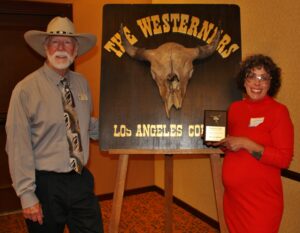
Roundup: July 13 2022
july22_roundup
Roundup Synopsis
July’s Roundup had Denny Thompson take us out on a history of Dodger Stadium. We enjoyed complimentary peanuts and Cracker Jack, but it was hard to root, root, root for the home team as Denny recounted the murky circumstances surrounding the Dodgers’ acquisition of the stadium site—the once vibrant community of Chavez Ravine. City councilman Julián Chávez purchased the rugged ravine in 1844. From its beginnings, Chavez Ravine was a refuge for many peoples. In the 1850s, it hosted a “Pest House” for Chinese and Mexican smallpox victims. Jewish-Americans settled the ravine in the 1860s, but were forced to relocate their cemetery to make room for oil derricks. By 1900, the area was largely Latino, closely knit, and civically engaged. Denny’s own father and grandparents lived in the Ravine at this time, between 1907 and 1922, before winning a dairy farm in Santa Clarita in a poker game. Chavez Ravine residents won a victory against the oil companies in 1926, when the city council banned industry there. However, the community could not resist the next challenges to its integrity. After WW2, city authorities designated Chavez Ravine a “blighted” neighborhood in need of redevelopment. In 1949, the new Los Angeles Housing Authority secured federal funding to build a public housing project on the site. Utilizing eminent domain, the city purchased the land for $10,300 per property. Homeowners felt pressured to accept this price, which dropped if they held out. As consolation, all former residents were promised preferential placement in the proposed housing project upon completion. Yet by the early 1950s, a specter haunted Los Angeles—the specter of communism. At least, that is how it was seen through the redtinted lens of McCarthyite paranoia. Several prominent “Citizens Against Socialistic Housing,” including then-actor Ronald Reagan, successfully pushed for a referendum that killed the Chavez Ravine housing project in 1952. However, Los Angeles had signed a housing contract with the U.S. government, and in 1954 the Feds only agreed to resell the property to the city for $1.3 million on condition the land be used for “a public purpose.” For 22-year-old city councilwoman Roz Wyman, that purpose was obvious. Los Angeles was a “Big League town” without a Big League baseball team, and needed one badly. Fortuitously for her, the Brooklyn Dodgers were an A-grade team with a D-grade home stadium. Wyman encouraged the Dodgers to move to L.A. in 1957, and team owner Walter O’Malley purchased Chavez Ravine from the city for $494,000 in order to build a new stadium. A 1958 ballot initiative to block the purchase narrowly failed, partly due to wording that confused voters. Sheriffs forcibly evicted the last remaining ten families from Chavez Ravine on May 9th, 1959, a day called “Black Friday” by some. Photos of the Archiga family being dragged out of their home made national headlines, but public sympathy diminished with the revelation that the family owned other properties elsewhere in L.A. Construction of Dodger Stadium was completed in 1962, to the tune of $20 million. The human cost was the exile of a thousand families from Chavez Ravine, the result of broken promises. No alternative public housing project was ever offered. These families were scattered all across Los Angeles, with many members having to split up as dictated by the availability of jobs and housing. The Dodgers, meanwhile, took two decades to find acceptance among Latino Angeleños, but the recruiting of Mexican southpaw pitcher Fernando Valenzuela finally broke the ice in 1980. The community of Chavez Ravine is now a fading memory, but their story is a timeless one concerning questions of eminent domain, public housing, and “public purpose” private property. Many thanks to Denny Thompson for this fascinating discussion. — John Dillon
Photos from the Roundup
TBD
Fandango Store
Fandango Form & Purchase
Instructions
To Inform our Registrar & Treasurer
1. Fill out the form below, review information, and click Submit below. (If you are planning on bringing more than four guests, please submit the form again with the additional guest’s names.) When you click the Submit button, this will confirm your reservation. This information will be sent via email to you, to our Treasurer and to our Registrar.
To pay & complete your purchase:
2. Click Buy Now below. You will be taken to PayPal. The following steps apply to the PayPal checkout process.
3. Enter total quantity of meals being purchased/guests attending under Your order summary then click Update.
4. If you have a PayPal account: under Choose a way to pay, you can enter your PayPal account information.
If you do not have a PayPal account: under Choose a way to pay, select Pay with debit or credit card, or Bill Me Later link and enter your billing information.
5. After entering your billing or account information on PayPal, click Pay. This will complete your purchase.


